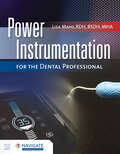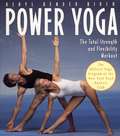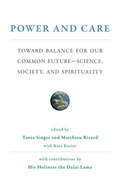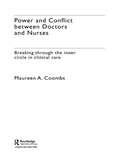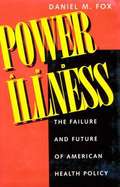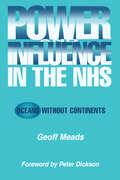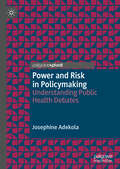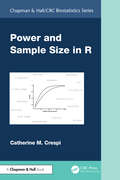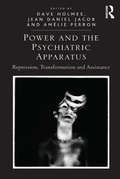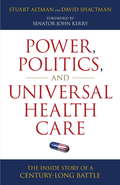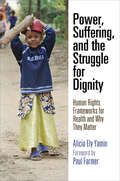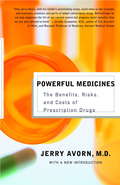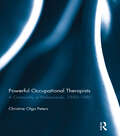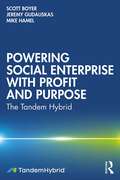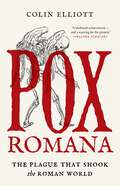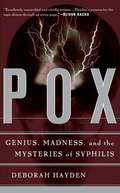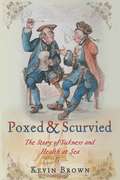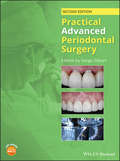- Table View
- List View
Power Instrumentation for the Dental Professional
by Lisa MayoThe field of dental ultrasonics and air polishing has become mainstream as the technology has evolved. Power Instrumentation for the Dental Professional aims to bridge the gap of knowledge between education and clinical practice by allowing the student to acquire the knowledge needed to implement power technology effectively into patient care with a contemporary approach to preventive, maintenance, and non-surgical periodontal procedures. As with any form of clinical practice, power instrumentation is best learned through continued repetition. The exercises in this textbook allow you to move at your own pace to gain proficiency. The videos that accompany the text will provide you with a chairside instructor that you can watch multiple times while developing your clinical skills.
Power Through Repose
by Annie Payson CallAs outspoken in his day as Richard Dawkins or Christopher Hitchens are today, American freethinker and author ROBERT GREEN INGERSOLL (1833-1899) was a notorious radical whose uncompromising views on religion and slavery (they were bad, in his opinion), women's suffrage (a good idea, he believed), and other contentious matters of his era made him a wildly popular orator and critic of 19th-century American culture and public life. As a speaker dedicated to expanding intellectual horizons and celebrating the value of skepticism, Ingersoll spoke frequently on such topics as atheism, freedom from the pressures of conformity, and the lives of philosophers who espoused such concepts. This collection of his most famous speeches includes the lectures: [ "The Gods" (1872) [ "Humboldt" (1869) [ "Thomas Paine" (1870) [ "Individuality" (1873) [ "Heretics and Heresies" (1874)
Power Yoga: The Total Strength and Flexibility Workout
by Beryl BirchTHE OFFICIAL YOGA PROGRAM OF THE NEW YORK ROAD RUNNERS CLUBPower Yoga is a unique combination of dynamic breathing and strong, flowing movement, which creates a high-heat, high-energy workout. Unlike any other yoga program, Power Yoga is a choreographed sequence of postures that flow into one another, building strength, unwinding tight joints, and loosening muscles. Beautiful photographs and clear instructions guide you through this effective and popular routine.Based on the classical and original yoga system called astanga, Power Yoga is a complete mind and body workout that develops concentration and reduces stress. With its focus on mindful breathing and body heat, Power Yoga goes beyond the relaxation benefits of traditional yoga to offer a route to health and fitness that athletes of all levels will embrace.
Power and Care: Toward Balance for Our Common Future#Science, Society, and Spirituality (The\mit Press Ser.)
by Matthieu Ricard Tania Singer Kate KariusLeading thinkers from a range of disciplines discuss the compatibility of power and care, in conversation with the Dalai Lama.For more than thirty years, the Dalai Lama has been in dialogue with thinkers from a range of disciplines, helping to support pathways for knowledge to increase human wellbeing and compassion. These conversations, which began as private meetings, are now part of the Mind & Life Institute and Mind & Life Europe. This book documents a recent Mind & Life Institute dialogue with the Dalai Lama and others on two fundamental forces: power and care—power over and care for others in human societies.The notion of power is essentially neutral; power can be used to benefit others or to harm them, to build or to destroy. Care, on the other hand, is not a neutral force; it aims at increasing the wellbeing of others. Power and care are not incompatible: power, imbued with care, can achieve more than a powerless motivation to care; power, without the intention to benefit others, can be ruthless. The contributors—who include such celebrated figures as Frans B. M. de Waal, Olafur Eliasson, Sarah Blaffer Hrdy, and Jody Williams—discuss topics including the interaction of power and care among our closest relatives, the chimpanzees; the effect of meditation and mental training practices on the brain; the role of religion in promoting peace and compassion; and the new field of Caring Economics.ContributorsPaul Collier, Brother Thierry-Marie Courau, Frans B. M. de Waal, Olafur Eliasson, Scilla Elworthy, Alexandra M. Freund, Tenzin Gyatso (His Holiness the Dalai Lama), Markus Heinrichs, Sarah Blaffer Hrdy, Frédéric Laloux, Alaa Murabit, Matthieu Ricard, Johan Rockström, Richard Schwartz, Tania Singer, Dennis J. Snower, Rabbi Awraham Soetendorp, Theo Sowa, Pauline Tangiora, Jody Williams
Power and Conflict Between Doctors and Nurses: Breaking Through the Inner Circle in Clinical Care
by Maureen A. CoombsThrough observations in three intensive care units, this book draws on the reality of practice to explore how nurses and doctors work in intensive care settings. It examines:· the power held by the competing knowledge bases· the roles of the different professions· the decision-making process· the sources of conflict· the need for change.Drawing together sociological theories and clinical practice, Power and Conflict Between Doctors and Nurses explores the role of nurses in delivering contemporary health care. It makes a strong case for interdisciplinary working and is particularly timely when health care policy is challenging work boundaries in health care.
Power and Illness: The Failure and Future of American Health Policy
by Daniel FoxThose who make health policy decisions have increased support for hospitals, physicians, and medical research, believing that people then would become healthier. This position, implemented at considerable cost, has not adequately taken into account the growing burden of chronic disabling illness. While decision makers may have defined chronic disease as a high priority in research, they have not given it such a priority in the financing of health services.
Power and Influence in the NHS: Oceans Without Continents
by Ian BanksExplains the NHS as a political environment, and concentrates on understanding the relationships of power rather than on the role of apparent authority. The book presents a range of management frameworks and personal examples to illustrate what a primary-care-led NHS means.
Power and Risk in Policymaking: Understanding Public Health Debates
by Josephine AdekolaThis book presents detailed accounts of policymaking in contemporary risk communication. Specifically, it expands on the understanding of the policy decision-making process where there is little or no evidential base, and where multiple interpretations, power dynamics and values shape the interpretation of public health risk issues. The book argues that public health risk communication is a process embedded within multiple dimensions of power and set out practical way forward for public health risk communication.
Power and Sample Size in R (Chapman & Hall/CRC Biostatistics Series)
by Catherine M. CrespiPower and Sample Size in R guides the reader through power and sample size calculations for a wide variety of study outcomes and designs and illustrates their implementation in R software. It is designed to be used as a learning tool for students as well as a resource for experienced statisticians and investigators. The book begins by explaining the process of power calculation step by step at an introductory level and then builds to increasingly complex and varied topics. For each type of study design, the information needed to perform a calculation and the factors that affect power are explained. Concepts are explained with statistical rigor but made accessible through intuition and examples. Practical advice for performing sample size and power calculations for real studies is given throughout.The book demonstrates calculations in R. It is integrated with the companion R package powertools and also draws on and summarizes the capabilities of other R packages. Only a basic proficiency in R is assumed.Topics include comparison of group means and proportions; ANOVA, including multiple comparisons; power for confidence intervals; multistage designs; linear, logistic and Poisson regression; crossover studies; multicenter, cluster randomized and stepped wedge designs; and time to event outcomes. Chapters are also devoted to designing noninferiority, superiority by a margin and equivalence studies and handling multiple primary endpoints.By emphasizing statistical thinking about the factors that influence power for different study designs and outcomes as well as providing R code, this book equips the reader with the knowledge and tools to perform their own calculations with confidence.Key Features: Explains power and sample size calculation for a wide variety of study designs and outcomes Suitable for both students and experienced researchers Highlights key factors influencing power and provides practical tips for designing real studies Includes extensive examples with R code
Power and Welfare: Understanding Citizens' Encounters with State Welfare (Social And Political Power Mup Ser.)
by Nanna Mik-Meyer Kaspar VillardsenIn the welfare provision of today, power takes both the shape of juridical sanctions and of attractive offers for self-development. When state institutions punish criminals, remove children at risk, or enforce sanctions upon welfare recipients the question of power is immediately urgent. It is less readily evident that power is at stake when institutions educate, counsel or ‘empower’ citizens. This book offers a framework for understanding and analyzing these complex and implicit forms of power at play in the encounters between citizens and welfare institutions. Taking as its starting point the idea that power takes many different shapes, and that different approaches to power may be necessary in the diverse contexts where citizens encounter welfare professionals, the book demonstrates how significant social theorists, spanning from Goffman to Foucault, can be used for inquiries into these encounters. Guiding the reader from their epistemological foundations to lucid ‘state of the art’ case examples, the book unpacks each of its six theoretical perspectives, and explains selected key concepts and explicates their potential for analysis. The final chapter discusses the usefulness of the theoretical approaches, their weaknesses and indicates some possibilities of theoretical integration. Including case studies of patients, nursing home residents, unemployed people, homeless people, and young offenders, from the USA, Denmark, France, Sweden, Canada, and Australia, Power and Welfare is designed for students and researchers of social policy, sociology, anthropology, political science, education, nursing and social work.
Power and the Psychiatric Apparatus: Repression, Transformation and Assistance
by Dave Holmes Jean Daniel JacobDrawing on a broad range of approaches in the fields of sociology, anthropology, political science, history, philosophy, medicine and nursing, Power and the Psychiatric Apparatus exposes psychiatric practices that are mobilized along the continuum of repression, transformation and assistance. It critically examines taken for granted psychiatric practices both past and current, shedding light on the often political nature of psychiatry and reconceptualizing its central and sensitive issues through the radical theory of figures such as Foucault, Deleuze and Guattari, Goffman, and Szasz. As such, this ground-breaking collection embraces a broad understanding of psychiatric practices and engages the reader in a critical understanding of their effects, challenging the discipline’s altruistic rhetoric of therapy and problematizing the ways in which this is operationalized in practice. A comprehensive exploration of contested psychiatric practices in healthcare settings, this interdisciplinary volume brings together recent scholarship from the US, Canada, the UK, Europe and Australia, to provide a rich array of theoretical tools with which to engage with questions related to psychiatric power, discipline and control, while theorizing their workings in creative and imaginative ways.
Power from Within: A Guide to Success as a Medical Malpractice Defense Expert
by Jeffrey A. Krompier, Esq.There is no end in sight to the frequency with which physicians, nursing professionals and other healthcare providers will become lawsuit targets in our litigious society. While politicians, practitioners, insurance companies and trial attorneys debate the nation’s chronic "malpractice crisis", suits continue to be filed. In addition, once COVID-19 is behind us and the unprecedented public support for health care providers wanes, as it will, it is anticipated that physicians and nurses will become malpractice defendants to a remarkable degree. National legislative fact-finding committees and investigative bodies, which may be charged with the responsibility of pursuing a solution, likely will never achieve a global remedy. Although curtailed by some states, national legislation has not addressed baseless malpractice suites or grossly excessive monetary verdicts. Another approach exists, however. Health care providers can impact the existing system and influence the malpractice environments in a tangible, positive and powerful fashion. Although there will be debate over tort reform in order to bring some degree of protection to the malpractice defendant, individual case success, defined from the defendant’s perspective as a "no-cause" trial verdict, can be realized if well-credentialed and experienced health care professionals are willing to assist the malpractice defense bar as expert witnesses. The benefits to the health care community and the individuals who are willing to participate are innumerable and worth considering.
Power, Politics, and Universal Health Care
by Stuart AltmanWhy was the Obama health plan so controversial and difficult to understand? In this readable, entertaining, and substantive book, Stuart Altman--inter-nationally recognized expert in health policy and adviser to five US presidents--and fellow health care specialist David Shactman explain not only the Obama health plan but also many of the intriguing stories in the hundred-year saga leading up to the landmark 2010 legislation. Blending political intrigue, policy substance, and good old-fashioned storytelling, this is the first book to place the Obama health plan within a historical perspective. The authors describe the sometimes haphazard, piece-by-piece construction of the nation's health care system, from the early efforts of Franklin Roosevelt and Harry Truman to the later additions of Ronald Reagan and George W. Bush. In each case, they examine the factors that led to success or failure, often by illuminating little-known political maneuvers that brought about immense shifts in policy or thwarted herculean efforts at reform. Despite its importance in history, few people know that Richard Nixon marshaled the best attempt to enact universal health care; or that he arranged secret health policy meetings with aides to Ted Kennedy in the basement of a Washington, DC, church. Who knew that the American Medical Association (AMA) publicly questioned the surgeon general's report that tobacco was harmful in order to defeat the Medicare bill, or that three separate sex scandals obstructed the road to universal health care? The authors look at key moments in health care history: the Hill-Burton Act in 1946, in which one determined poverty lawyer secured the rights of the uninsured poor to get hospital care; the "three-layer cake" strategy of powerful House Ways and Means Committee Chairman Wilbur Mills to enact Medicare and Medicaid under Lyndon Johnson in 1965; the odd story of how Medicare catastrophic insurance was passed by Ronald Reagan in 1988 and then repealed because of public anger in 1989; and the fact that the largest and most expensive expansion of Medicare was enacted by George W. Bush in 2003. President Barack Obama is the protagonist in the climactic chapter, learning from the successes and failures chronicled throughout the narrative. The authors relate how, in the midst of a worldwide financial meltdown, Obama overcame seemingly impossible obstacles to accomplish what other presidents had tried and failed to achieve for nearly one hundred years. This book is essential reading for every American who must navigate the US health care system.
Power, Suffering, and the Struggle for Dignity: Human Rights Frameworks for Health and Why They Matter (Pennsylvania Studies in Human Rights)
by Alicia YaminDirected at a diverse audience of students, legal and public health practitioners, and anyone interested in understanding what human rights-based approaches (HRBAs) to health and development mean and why they matter, Power, Suffering, and the Struggle for Dignity provides a solid foundation for comprehending what a human rights framework implies and the potential for social transformation it entails. <P><P>Applying a human rights framework to health demands that we think about our own suffering and that of others, as well as the fundamental causes of that suffering. What is our agency as human subjects with rights and dignity, and what prevents us from acting in certain circumstances? What roles are played by others in decisions that affect our health? How do we determine whether what we may see as "natural" is actually the result of mutable, human policies and practices? <P><P>Alicia Ely Yamin couples theory with personal examples of HRBAs at work and shows the impact they have had on people's lives and health outcomes. Analyzing the successes of and challenges to using human rights frameworks for health, Yamin charts what can be learned from these experiences, from conceptualization to implementation, setting out explicit assumptions about how we can create social transformation. <P><P>The ultimate concern of Power, Suffering, and the Struggle for Dignity is to promote movement from analysis to action, so that we can begin to use human rights frameworks to effect meaningful social change in global health, and beyond.
Powerful Medicines: The Benefits, Risks, and Costs of Prescription Drugs
by Jerry AvornPraised by Senator Edward Kennedy and others (including Nobel Peace Prize winner Bernard Lown), this book uses numerous case studies to demonstrate how pharmaceutical companies' marketing and research practices distort the process of balancing drug benefits, hazards, and cost which is meant to ensure that patients receive quality, affordable care. His recommendations for treatment include better use of technology, better patient education, and thorough comparisons of the effectiveness and safety of similar drugs. Annotation ©2004 Book News, Inc. , Portland, OR (booknews. com)
Powerful Occupational Therapists: A Community Of Professionals, 1950-1980
by Christine Olga PetersPowerful Occupational Therapists examines the life and times of a small group of occupational therapy leaders and scholars in a post-1950s America, to market their profession as one of increasing importance. Participating in the 1950s rehabilitation, the 1960s equal rights, and the 1970s women’s movements, these innovators, being primarily women, aimed to define themselves as having professional and scientific authority that was distinct from the male-dominated medical model. The community of therapists faced challenges such as that of retaining the appearance of being "ladylike" whilst doing "unladylike" tasks. This book describes the personal experiences of 12 differing occupational therapists and it identifies how a group of them strengthened and developed the profession in the face of diverse challenges. This volume would be of interest to those studying occupational therapy, women and medicine and the history of medicine. This book was originally published as a special issue of Occupational Therapy in Mental Health.
Powering Social Enterprise with Profit and Purpose: The Tandem Hybrid
by Scott Boyer Jeremy Gudauskas Mike HamelTrail-blazing social entrepreneurs are tackling the world’s most pressing problems that government, business, or charity have failed to solve. They are creating businesses with a primary mission of social change. Scott Boyer is one such social entrepreneur. This 28-year veteran of Big Pharma left a six-figure salary to start OWP Pharmaceuticals and the ROW Foundation. This commercial business and non-profit organization exist in a symbiotic relationship we call a "tandem hybrid social enterprise." This model combines a multimillion dollar business with a foundation that’s on track to become the largest funder of projects serving people with epilepsy and associated psychiatric disorders in the world. The tandem hybrid incorporates the principles learned by Scott and others for building a truly unique social enterprise from the ground up; one that is: Driven by a compelling social mission Financed by commercial success Structured to retain control Scalable and sustainable for the long haul Powering Social Enterprises With Profit And Purpose offers a detailed blueprint that has proven commercially and philanthropically successful and that can be replicated in most business sectors.
Powering Social Enterprise with Profit and Purpose: The Tandem Hybrid
by Scott Boyer Jeremy Gudauskas Mike HamelTrail-blazing social entrepreneurs are tackling the world’s most pressing problems that government, business, or charity have failed to solve. They are creating businesses with a primary mission of social change. Scott Boyer is one such social entrepreneur. This 28-year veteran of Big Pharma left a six-figure salary to start OWP Pharmaceuticals and the ROW Foundation. This commercial business and non-profit organization exist in a symbiotic relationship we call a "tandem hybrid social enterprise." This model combines a multimillion dollar business with a foundation that’s on track to become the largest funder of projects serving people with epilepsy and associated psychiatric disorders in the world.The tandem hybrid incorporates the principles learned by Scott and others for building a truly unique social enterprise from the ground up; one that is: Driven by a compelling social mission Financed by commercial success Structured to retain control Scalable and sustainable for the long haul Powering Social Enterprises With Profit And Purpose offers a detailed blueprint that has proven commercially and philanthropically successful and that can be replicated in most business sectors.
Pox Americana: The Great Smallpox Epidemic of 1775-82
by Elizabeth Anne FennThe story that follows is about Variola major, the virus that causes smallpox. From 1775 to 1782, Variola ravaged the greater part of North America, from Mexico to Massachusetts, from Pensacola to Puget Sound. For the virus, the great pestilence represented a phenomenal success: It found countless new hosts, it multiplied rapidly, and it traveled vast distances. But in its wake it left death and despair, killing more than a hundred thousand people and maiming many more. With no respect for boundaries of race, class, or nationality, the opportunistic microbe swept an astonishing array of people and events into its maelstrom: missionaries, mariners, fur traders, explorers, planters, fishermen, hunters, farmers, homemakers, warriors, neophytes, trappers, soldiers, prisoners, and runaway slaves. By the time the pestilence was over, it had reshaped human destinies across the continent...
Pox Romana: The Plague That Shook the Roman World (Turning Points in Ancient History #15)
by Colin ElliottA wide-ranging and dramatic account of the Antonine plague, the mysterious disease that struck the Roman Empire at its pinnacleIn the middle of the second century AD, Rome was at its prosperous and powerful apex. The emperor Marcus Aurelius reigned over a vast territory that stretched from Britain to Egypt. The Roman-made peace, or Pax Romana, seemed to be permanent. Then, apparently out of nowhere, a sudden sickness struck the legions and laid waste to cities, including Rome itself. This fast-spreading disease, now known as the Antonine plague, may have been history&’s first pandemic. Soon after its arrival, the Empire began its downward trajectory toward decline and fall. In Pox Romana, historian Colin Elliott offers a comprehensive, wide-ranging account of this pivotal moment in Roman history.Did a single disease—its origins and diagnosis still a mystery—bring Rome to its knees? Carefully examining all the available evidence, Elliott shows that Rome&’s problems were more insidious. Years before the pandemic, the thin veneer of Roman peace and prosperity had begun to crack: the economy was sluggish, the military found itself bogged down in the Balkans and the Middle East, food insecurity led to riots and mass migration, and persecution of Christians intensified. The pandemic exposed the crumbling foundations of a doomed Empire. Arguing that the disease was both cause and effect of Rome&’s fall, Elliott describes the plague&’s &“preexisting conditions&” (Rome&’s multiple economic, social, and environmental susceptibilities); recounts the history of the outbreak itself through the experiences of physician, victim, and political operator; and explores postpandemic crises. The pandemic&’s most transformative power, Elliott suggests, may have been its lingering presence as a threat both real and perceived.
Pox: Genius, Madness, And The Mysteries Of Syphilis
by Deborah HaydenFrom Beethoven to Oscar Wilde, from Van Gogh to Hitler, Deborah Hayden throws new light on the effects of syphilis on the lives and works of seminal figures from the fifteenth to the twentieth centuries. Writing with remarkable insight and narrative flair, Hayden argues that biographers and historians have vastly underestimated the influence of what Thomas Mann called "this exhilarating yet wasting disease. " Shrouded in secrecy, syphilis was accompanied by wild euphoria and suicidal depression, megalomania and paranoia, profoundly affecting sufferers' worldview, their sexual behavior, and their art. Deeply informed and courageously argued, Pox has been heralded as a major contribution to our understanding of genius, madness, and creativity.
Poxed & Scurvied: The Story of Sickness and Health at Sea
by Kevin Brown&“A fascinating and wide-ranging history of health, hygiene, and the sea. This is a great narrative of an important but often hidden aspect of seafaring.&” —Ausmarine When European sailors began to explore the rest of the world, the problem of keeping healthy on such long voyages became acute. Malnourishment and crowded conditions bred disease, but they also carried epidemics that decimated the indigenous populations they encountered and brought back new diseases like syphilis. As navies developed, the well-being of crews became a dominant factor in the success of naval operations, so it is no surprise that the Royal Navy led the way in shipboard medical provision, and sponsored many of the advances in diet and hygiene which by the Napoleonic Wars gave its fleets a significant advantage over all its enemies. These improvements trickled down to the merchant service, but the book also looks at two particularly harsh maritime environments, the slave trade and emigrant ships, both of which required special medical arrangements. Eventually, the struggle to improve the fitness of seamen became a national concern, manifest in a series of far-reaching and sometimes bizarre public health measures, generally directed against the effects of drunkenness and the pox. In this way, as in many others, an attempt to address the specific needs of the seafarer developed wider implications for society as a whole. It also produced scientific breakthroughs that were a universal benefit, so far from being a narrow study of medicine at sea, this book provides a fascinating picture of social improvement. &“The topics are intriguing, the research is thorough, and the book is a captivating read.&” —Nautical Research Journal
Poxviruses (Advances in Experimental Medicine and Biology #1451)
by Nima RezaeiSince the emergence of 2022’s monkeypox virus (MPXV) outbreak, it has been the heading of news and research articles that MPXV is being involving non-endemic areas after about its 80-year presence in endemic areas. Efforts are concentrated on understanding how MPXV has evolved to cause an epidemic. The book provides a comprehensive compendium of chapters on poxviruses in different domains. It concludes that the main problem we should deal with is not to address how MPXV has overcome the distance between non-endemic and endemic areas, but it is the non-cooperativity of logistics, research, and science in managing poxviruses’ outbreaks.
Practical 3D Echocardiography
by Francesco F. Faletra Samuel J. Asirvatham Joseph F. Maalouf Krishnaswamy ChandrasekaranThis extensive clinically focused book is a detailed practical 3D echocardiography imaging reference that addresses the concerns and needs of both the novice and experienced 3D echocardiographer. Chapters have been written in a highly instructive and practical disease- and problem-oriented approach supported by illustrative high-quality images (and corresponding 3D echo video clips where applicable) that demonstrate the incremental value of 3D echocardiography over 2D echocardiography in practice. Practical 3D Echocardiography is an intuitive guide to 3D imaging – what to look for, how to look for it, the best and special views, caveats and pitfalls when applicable, and clinical pearls and pointers – that can be used in daily practice. It is therefore of immense value to any practicing or trainee echocardiographer, cardiologist and internist.
Practical Advanced Periodontal Surgery
by Serge DibartA fully updated second edition of this well-illustrated guide to advanced surgical procedures in periodontology Practical Advanced Periodontal Surgery, Second Edition is a step-by-step guide to cutting-edge surgical techniques and interdisciplinary treatment approaches in periodontology. Written by leading experts in the field, the book provides solutions to complex daily dental challenges with innovative approaches to each treatment modality. Procedures are described in a practical and accessible style, highlighting complex and advanced procedures using a highly illustrated visual format. This expanded edition includes three new chapters that cover IV sedation, digital technologies in clinical restorative dentistry, and advanced implant therapies in the esthetic zone post extraction. Well balanced and solidly grounded in the science, this reference work is an indispensable resource for the practitioner of advanced dentistry. This important guide: • Offers an easy-to-use, practical step-by-step format • Contains clinical photographs that detail the surgical procedures presented • Reviews the most advanced techniques in periodontal surgery and their integration with digital treatment planning and workflow • Discusses the pros and cons for each procedure, as well as limitations and potential complications • Features video clips illustrating key points in the procedures described on a companion website Written for periodontists, periodontal residents and general or restorative dentists, this revised edition of Practical Advanced Periodontal Surgery is a practical and complete clinical manual filled with illustrations for easy reference.
